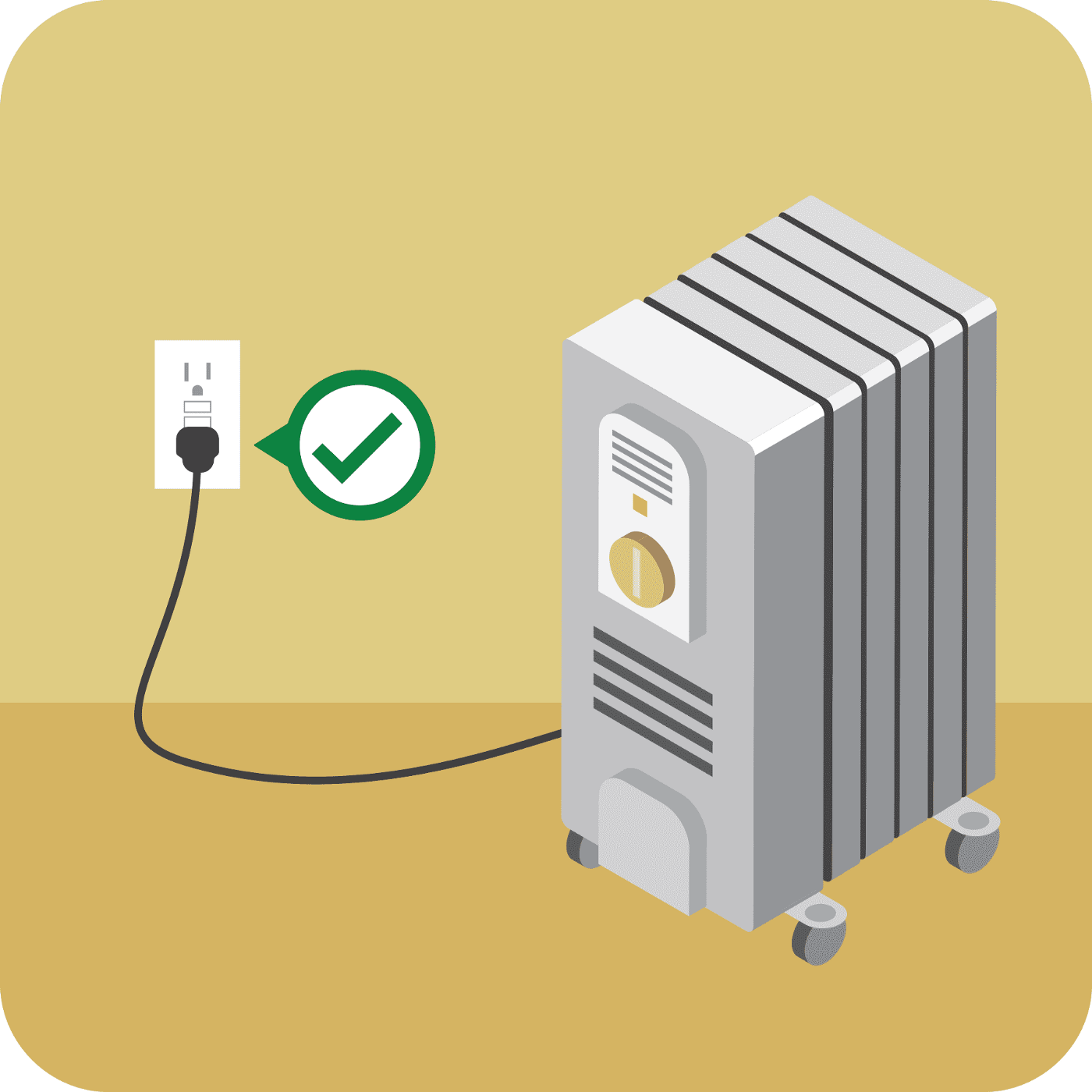Neighbors,
Below are 12 high-performing Polls that break past apathy and educate your community to keep them safe as the weather turns colder. We encourage you to share 1 to 2 polls each week on Nextdoor.
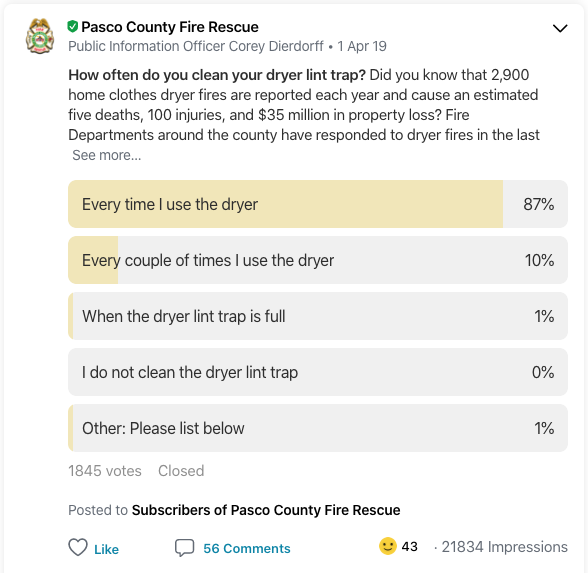
Did you know that you can download poll results by neighborhoods or service areas to see the aggregate results by geography? To do this, from the drop-down menu to the right of your agency’s name at the top of your Poll, select the options to download by neighborhood or service area. You can also make charts (google sheets makes it easy) of aggregate responses by geography and share the results on your other social channels and the media.

Here is the list of Polls you will find below:
- How do you plug in your space heater?
- Do you have carbon monoxide alarms in your home?
- Is it safe to use an oven or stovetop to heat your home?
- Do you know the signs of Hypothermia?
- Is your home fire safe for the holidays?
- Did you know December is the peak time of year for home candle fires?
- Is your vehicle winter storm ready, and does it have all of the following items?
- Do you know the difference between a Blizzard Warning, Winter Storm Warning, and a Winter Weather Advisory?
- Are you planning to shovel a 3-foot perimeter around fire hydrants?
- Did you know you can use the Nextdoor Help Map to offer help shoveling
- Stressed out, did you know practicing gratitude can help?
Instructions for posting:
- Copy and paste the text below.
- Click the “download image” link and save it to your computer.
- Sign in to your Nextdoor account (or reset your password).
- Post the message, along with the image, to your entire service area or the services areas affected.
- If you are having other issues, please visit our help center.
Poll description:
Neighbors,
According to the National Fire Protection Association, nearly half (48%) of home heating equipment fires are reported during the months of December, January & February. While more than two of five (44%) of home heating fires involve space heaters, space heaters are involved in 86% of home heating fire deaths.
Heating equipment continues to be the second leading cause of home fires behind cooking and the second leading cause of home fire deaths behind smoking.
If you are using a space heater to warm up, please be sure to plug all space heaters directly into a wall outlet and always turn it off when leaving the room or going to bed.
You will also want to establish a 3-foot kid and pet-free zone around the heater, and never put a space heater in a child’s room. Finally, keep your space heaters at least 3 feet away from combustible materials like furniture, bedding, and curtains.
Here is more information on winter heating and space heaters. https://www.nfpa.org/public-education/by-topic/top-causes-of-fire/heating
If you use a space heater, tell us how you plug in your space heater by selecting one option below.
If you have other tips, share them below in the comments. Please also consider sharing the message via the share button below on your other social networks.
Poll options:
- Directly into the wall
- Into a power strip
- Into an extension cord
- I don’t use a space heater
Poll subject: Do you have carbon monoxide alarms in your home?
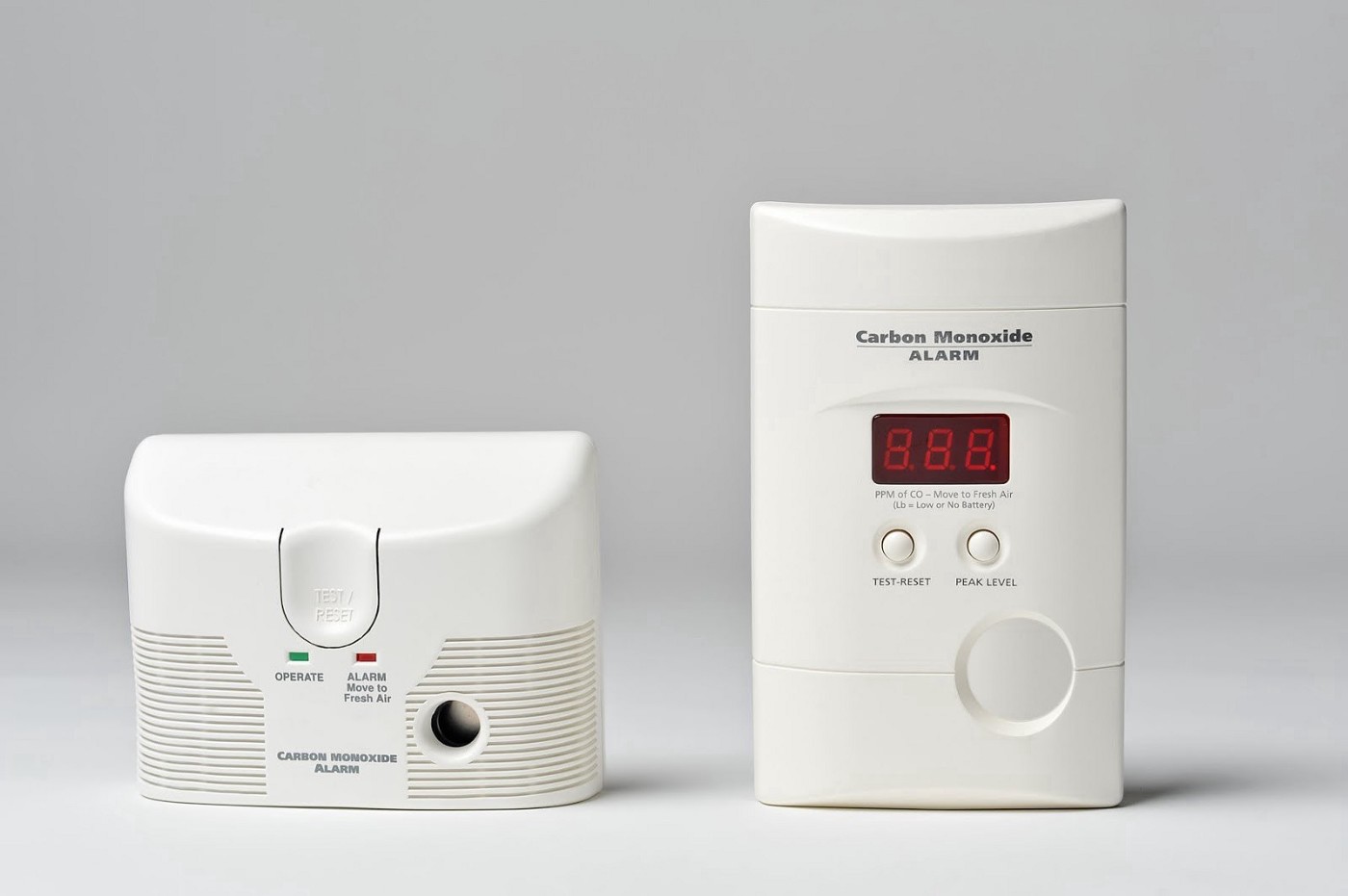
For “Ask a question”: Do you have carbon monoxide alarms in your home?
Poll description:
What is carbon monoxide?
Carbon monoxide, also known as CO, is called the “Invisible Killer” because it’s a colorless, odorless, poisonous gas. More than 150 people in the United States die every year from accidental non-fire-related CO poisoning associated with consumer products, including generators. Other products include faulty, improperly-used or incorrectly-vented fuel-burning appliances such as furnaces, stoves, water heaters, and fireplaces.
Because CO is odorless, colorless, and otherwise undetectable to the human senses, people may not know that they are being exposed. The initial symptoms of low to moderate CO poisoning are similar to the flu (but without the fever). They include:
- Headache
- Fatigue
- Shortness of breath
- Nausea
- Dizziness
High-level CO poisoning results in progressively more severe symptoms, including:
- Mental confusion
- Vomiting
- Loss of muscular coordination
- Loss of consciousness
- Ultimately death
Below, tell us you have carbon monoxide alarms in your home. If you don’t, we strongly urge you to get one for your home now.
If you have other tips, share them below in the comments. Please also consider sharing the message via the share button below on your other social networks.
Poll options:
- Yes
- No
- I don’t know
Poll subject: Is it safe to use an oven or stovetop to heat your home?
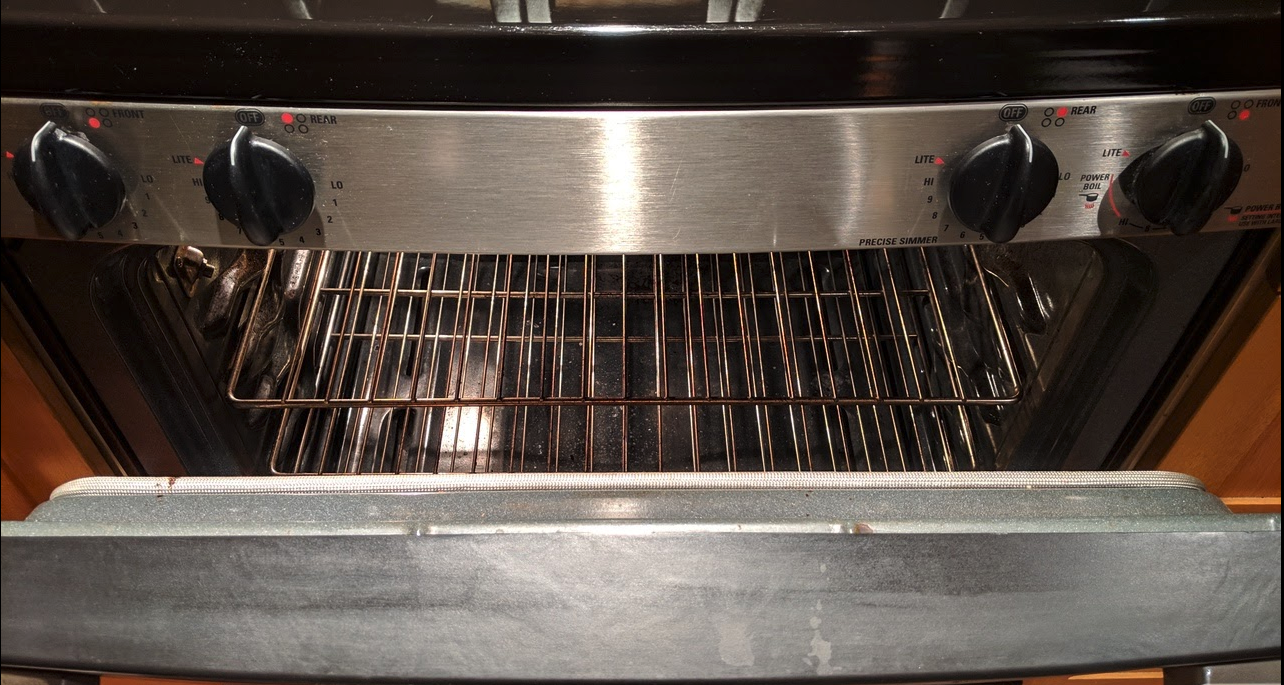
Poll description:
Neighbors,
Now that the temperatures have dropped, we wanted to remind you that ovens and stovetops were never designed for heating homes only, and doing so can lead to Carbon Monoxide poisoning.
Carbon Monoxide (CO) is an invisible, odorless gas that is emitted anytime combustion appliances (such as gas ovens and stoves) are used. If a gas oven or stovetop is misused, dangerous levels of CO occur.
Signs of carbon monoxide poisoning include a dull headache, weakness, dizziness, nausea or vomiting, shortness of breath, confusion, blurred vision, and loss of consciousness. If you develop these symptoms immediately leave your home and then call 911.
Never use a gas oven or stovetop to heat your home and have them inspected annually by a professional. Also, be sure to keep anything flammable such as paper towels, drying clothes, food packaging, or anything that could catch fire at least 3 feet away from the stove and oven.
It is also important to ensure your home has both smoke and carbon monoxide detectors, for more information visit — https://www.usfa.fema.gov/prevention/technology/.
If you have other tips, share them below in the comments. Please also consider sharing the message via the share button below on your other social networks.
Poll options:
- No
- No
-
No
Poll subject: Do you know the signs of hypothermia?
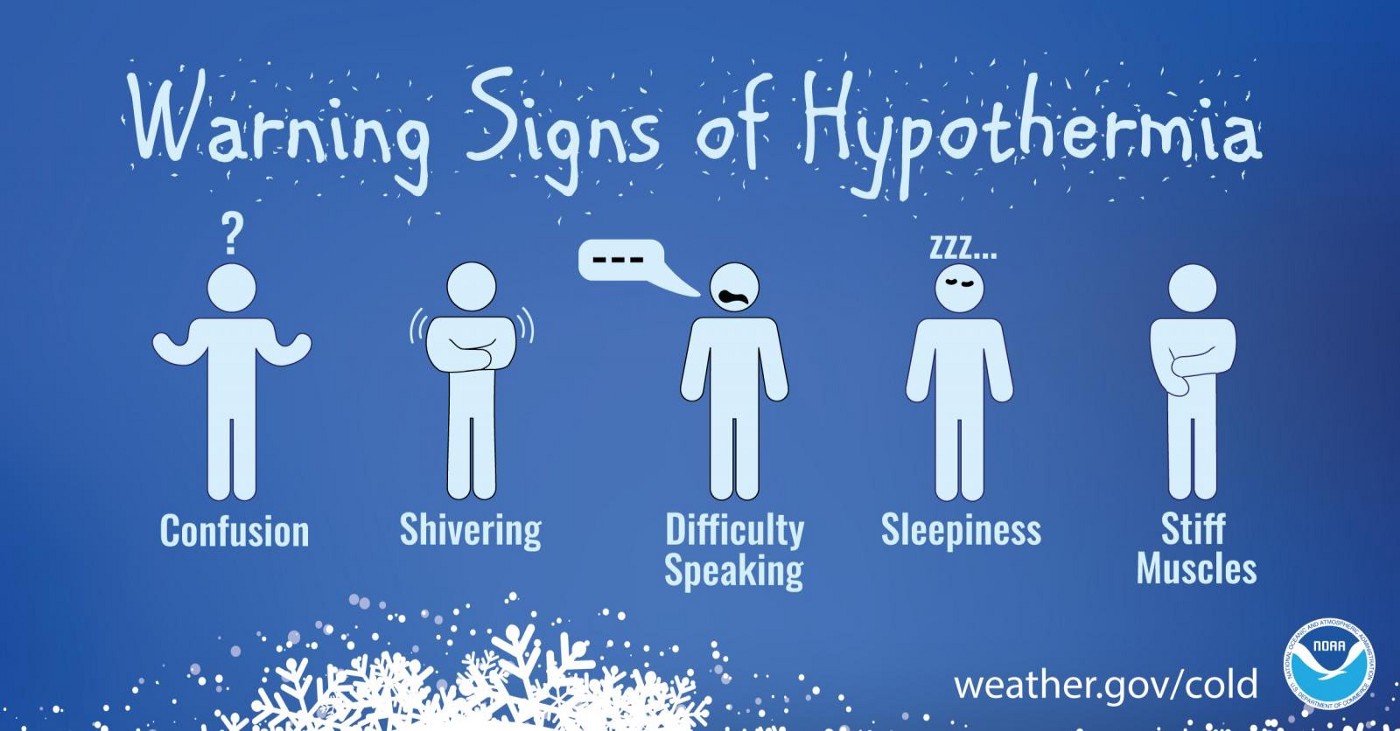
Poll description:
Hi Neighbors,
According to the Mayo Clinic, hypothermia is a medical emergency that occurs when your body loses heat faster than it can produce heat, causing a dangerously low body temperature. Normal body temperature is around 98.6 F (37 C). Hypothermia (hi-poe-THUR-me-uh) occurs as your body temperature falls below 95 F (35 C).
When your body temperature drops, your heart, nervous system, and other organs can’t work normally. Left untreated, hypothermia can eventually lead to complete failure of your heart and respiratory system and eventually to death.
Hypothermia is often caused by exposure to cold weather or immersion in cold water. Primary treatments for hypothermia are methods to warm the body back to a normal temperature.
Shivering is likely the first thing you’ll notice as the temperature starts to drop because it’s your body’s automatic defense against cold temperature — an attempt to warm itself.
Signs and symptoms of hypothermia include:
- Shivering
- Slurred speech or mumbling
- Slow, shallow breathing
- Weak pulse
- Clumsiness or lack of coordination
- Drowsiness or very low energy
- Confusion or memory loss
- Loss of consciousness
- Bright red, cold skin (in infants)
Someone with hypothermia usually isn’t aware of his or her condition because the symptoms often begin gradually. Also, the confused thinking associated with hypothermia prevents self-awareness. Confused thinking can also lead to risk-taking behavior
Call 911 or your local emergency number if you suspect someone has hypothermia.
While you wait for emergency help to arrive, gently move the person inside if possible. Jarring movements can trigger dangerous irregular heartbeats. Carefully remove his or her wet clothing, replacing it with warm, dry coats or blankets.
If you’ve experienced hypothermia, know someone who has, or if you have other tips to share, please comment below. Please also consider sharing the message via the share button below on your other social networks.
Poll options:
- Yes, I do know the signs of hypothermia
- I know some of the signs, but not all
- I did not, but now I do
Poll subject: Is your home fire safe for the holidays?
(Credit to Andrew Beckett, Ready Wisconsin)

Poll description:
Neighbors,
As families decorate their homes for the holiday season, we are urging everyone to keep fire safety in mind. While decorations can help to brighten up the holidays for many people, it’s important to make sure they are installed correctly so they don’t become a hazard to your safety or your home.
With both live and artificial Christmas trees, it’s important to take extra safety precautions when placing them inside your home. It only takes a few seconds for a tree to ignite into a large blaze. Never place a live tree close to a heat source, such as a fireplace or heat vent. The heat will dry out the tree, causing it to be more easily ignited by heat, flame, or sparks. Be sure to water your live Christmas tree every day.
According to the U.S. Fire Administration, electrical problems cause one out of every four Christmas tree fires. Make sure you inspect holiday lights each year and replace string lights that have worn or broken cords or loose bulb connections. Follow manufacturer’s instructions for limits on the number of light strands that can be connected. Remember some lights are only for indoor or outdoor use, but not both.
When it comes to holiday lights, it’s not uncommon to find a shortage of outlets to plug everything in. While it may be tempting, avoid overloading electrical outlets. Do not link more than three light strands unless the directions indicate it is safe. Make sure to periodically check the light strands while those decorations are in use. If they are warm to the touch, unplug and remove them. Be sure to turn off all lights on trees and other decorations when going to bed or leaving the house. Unplug extension cords when they are not in use.
Most home fires caused by candles occur on Christmas Eve, Christmas, and New Year’s Day. Never leave a burning candle unattended, and make sure they are kept at least 12 inches away from things that can burn. Instead of lighting real candles, consider using battery-operated flameless candles — that way you won’t need to worry about forgetting to blow them out, or the candle being accidentally knocked over by pets or children.
To help alert you to fire danger, make sure you have working smoke alarms installed on every level of your home. Test them monthly. Keep them clean and equipped with fresh batteries. Know when and how to call for help and remember to practice your home escape plan.
If you have other tips, share them below in the comments. Please also consider sharing the message via the share button below on your other social networks.
Which option below best describes how you are keeping your home safe?
Happy Holidays!
Poll options:
- We are keeping our home safe by following ALL these precautions
- We are keeping our home safe by following SOME of these precautions
- Thanks for the info, will give this some thought
- Other
Poll subject: Did you know December is the peak time of year for home candle fires?
(Credit, Mike Ball, Milwaukee Fire)

Poll description:
Happy Holidays to all!
Did you know that from 2012–2016, U.S. fire departments responded to an estimated 8,200 home structure fires that were started by candles? These fires caused an annual average of 80 deaths, 770 injuries, and $264 million in direct property damage.
Also, between 2012–2016:
- Candles caused 2% of reported home fires, 3% of home fire deaths, 7% of home fire injuries, and 4% of the direct property damage in home fires.
- Roughly one-third (37%) of home candle fires started in bedrooms. These fires caused 30% of the associated deaths and 50% of the associated injuries.
- Falling asleep was a factor in 11% percent of the home candle fires and 21% of the associated deaths.
- On average, 23 home candle fires were reported per day.
- Three of every five (60%) of home candle fires occurred when some form of combustible material was left or came too close to the candle.
Source: NFPA “Home Candle Fires” report
23 Fires daily on average is no small number! So, if you are using candles, please be safe by keeping them at least 12" from any object. If you leave the room or go to bed, extinguish the candle! Your best bet is to use battery-operated candles.
Finally, if you have cats or small children, you need to be especially vigilant! Please spread the word to your friends and family who burn candles too. Also, feel free to share your tips below.
If you have other tips, share them below in the comments. Please also consider sharing the message via the share button below on your other social networks.
Happy Holidays!
Poll options:
- Yes, I knew this
- Had no idea, thanks
- Other
Poll subject: Is your vehicle winter storm ready, and does it have all of the following items?

Poll description:
Each year, on average, more than 5,000 people are killed and more than 418,000 are injured due to weather-related vehicle crashes. If you need to drive in snow or cold conditions, TAKE IT SLOW IN THE SNOW. Black ice can be difficult to see. If the temperature is near freezing, drive like you’re on ice — you may be!
Before you leave the house, especially before a long trip in winter, make sure all fluid levels are full and ensure that the lights, heater, and windshield wipers are in proper condition. Keep your gas tank near full to avoid ice in the tank and fuel lines. Avoid traveling alone. Let someone know your timetable and primary and alternate routes. Then call 511 for the latest traffic and road incidents, including construction and weather conditions and restrictions. Every state offers this Department of Transportation service. Call before you leave; it might change your plans!
Fully check and winterize your vehicle before the winter season begins. Carry a Winter Storm Survival Kit that includes the following:
- Mobile phone and charger
- Blankets/sleeping bags
- Flashlight with extra batteries
- First-aid kit
- Knife
- High-calorie, non-perishable food
- Extra clothing to keep dry
- Large empty can to use as an emergency toilet, tissues, toilet paper, and paper towels
- Small can and waterproof matches to melt snow for drinking water
- Sack of sand or cat litter for traction
- Shovel
- Windshield scraper and brush
- Tool kit
- Tow rope
- Battery booster cables
- Water container
- Candle and matches to provide light and in an emergency, lifesaving heat.
- Compass and road maps, don’t depend on mobile devices with limited battery life
If you have other tips, share them below in the comments. Please also consider sharing the message via the share button below on your other social networks.
Poll options:
- Yes, my vehicle has all of the items
- Getting there, my vehicle has some of the items
- No, my vehicle has none of these items
Poll subject: Do you know the difference between a Blizzard Warning, Winter Storm Warning, and a Winter Weather Advisory?
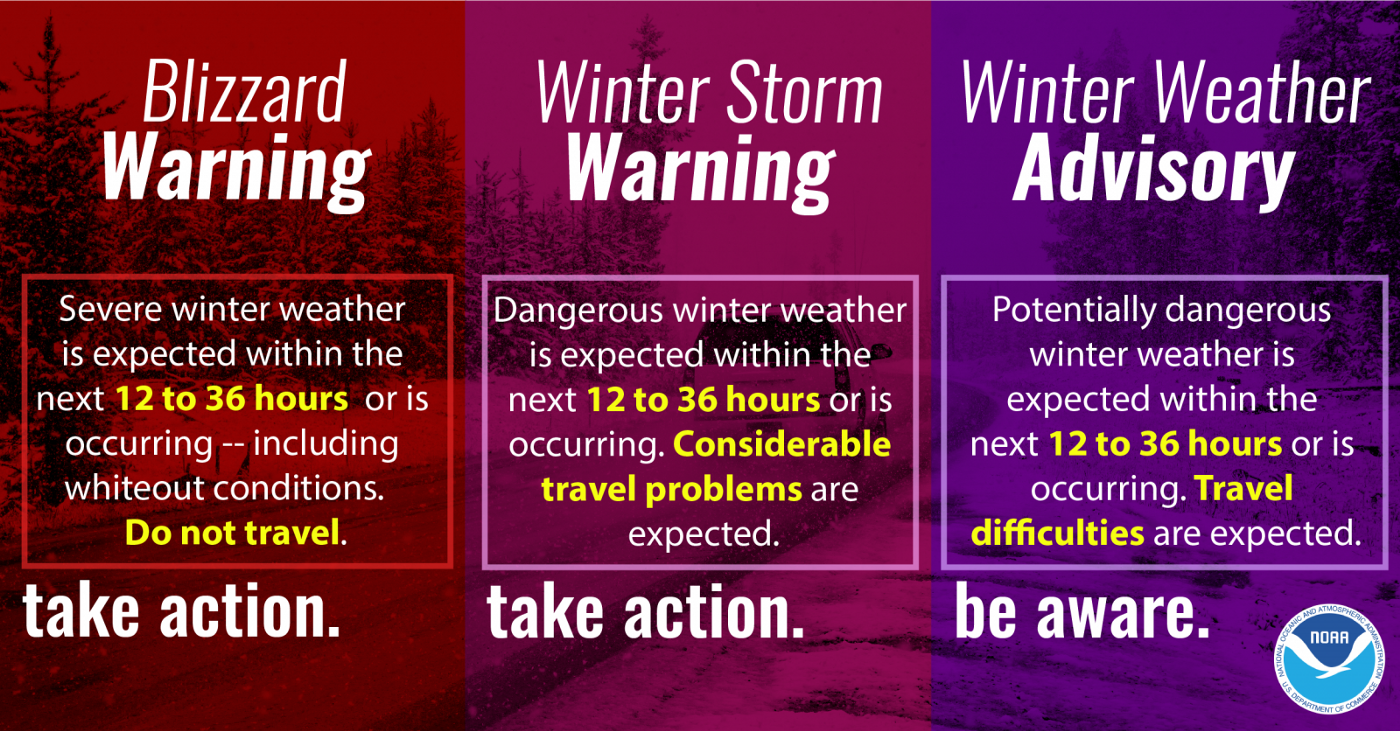
Poll description:
Neighbors,
Did you know the following?
A Blizzard Warning means severe weather is expected within the next 12 to 36 hours or it is occurring — including whiteout conditions. DO NOT TRAVEL.
A Winter Storm Warning means dangerous winter weather is expected within the next 12 to 36 hours, or it is occurring. Considerable travel problems are expected. It’s best not to travel.
A Winter Weather Advisory means potentially dangerous winter weather is expected within the next 12 to 36 hours or is occurring. Travel difficulties are expected, and you should plan ahead.
The primary concerns at home or work during a winter storm are loss of heat, power, and telephone service and a shortage of supplies if storm conditions continue for more than a day.
In either place, you should have available:
- Flashlight and extra batteries
- Battery-powered NOAA Weather Radio and portable radio to receive emergency information
- Extra food and water such as dried fruit, nuts, granola bars, and other food requiring no cooking or refrigeration.
- Extra prescription medicine
- Baby items such as diapers and formula
- First-aid supplies
- Heating fuel: refuel before you are empty; fuel carriers may not reach you for days after a winter storm
- Emergency heat source: fireplace, wood stove, or space heater properly ventilated to prevent a fire
- Fire extinguisher, smoke alarm; test smoke alarms monthly to ensure they work properly
- Extra pet food and warm shelter for pets
- Review generator safety — http://www.weather.gov/nwsexit.php?site=nws&url=http://www.redcross.org/prepare/disaster/power-outage/safe-generator-use — never run a generator in an enclosed space
- Make sure your carbon monoxide detector is working correctly and that the outside vent is clear of leaves and debris. During or after the storm, make sure it is cleared of snow.
- Home fires — https://www.ready.gov/home-fires are common each winter when trying to stay warm. Review ways to keep your home and loved ones safe.
If you have other tips, share them below in the comments. Please also consider sharing the message via the share button below on your other social networks.
Poll options:
- Yes, I did
- I do now, thanks
- Other
Poll: Are you planning to shovel a 3-foot perimeter around fire hydrants?
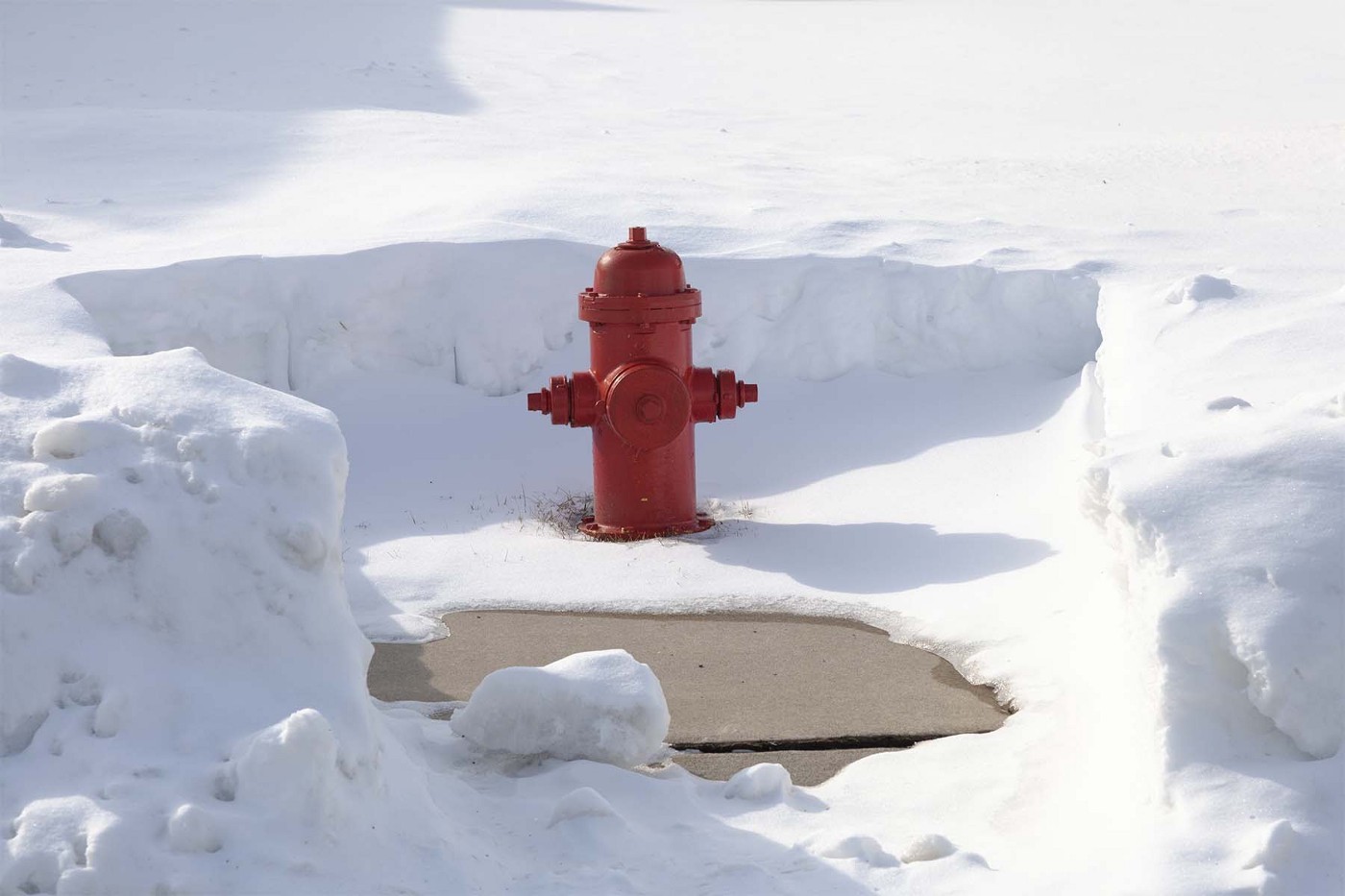
Poll description:
In an emergency, every second counts. Fire hydrants that are blocked, concealed, or difficult to access due to snow or ice and impede emergency fire response.
Fire trucks carry a limited amount of water, so one of the first tasks upon arriving at a fire is to locate a water supply from the nearest hydrant. Hydrants covered in snow can be difficult to locate, and uncovering them can waste valuable time needed during a fire. Keeping fire hydrants clear can mean easier access to water and more time doing what really matters — fighting the fire.
Pick one option below, and if you selected yes, please share any tips you have with your neighbors as a comment. Please also consider sharing the message via the share button below on your other social networks.
Poll options:
- Yes, I am planning to shovel a 3-foot perimeter around fire hydrants
- No, I am not planning to shovel a 3-foot perimeter around fire hydrants
Poll subject: Did you know you can use Nextdoor to offer and ask for help shoveling?
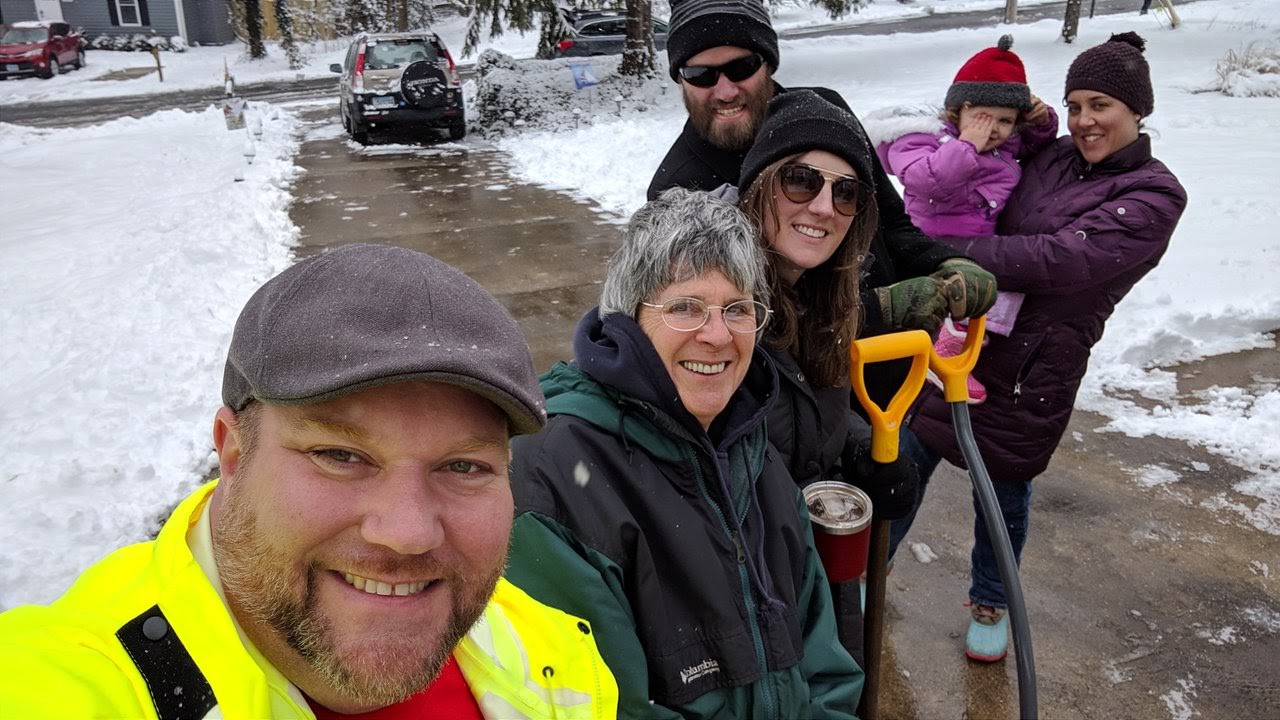
Poll description:
Dear Neighbors,
While snowstorms are exciting for many of us, for neighbors who are older, injured, or have a disability, snowstorms can cause a great deal of anxiety and pose a threat to their well-being.
If you would like to lend a hand and shovel out a neighbor in need, you can add yourself to the Nextdoor Help Map — https://nextdoor.com/help_map.
If you need help, search the help map to see who nearby is willing to help and send a message to the person closest to you. Alternatively, you can ask for help shoveling by posting into the Nextdoor newsfeed. Here is how — https://help.nextdoor.com/s/article/How-to-post?
In addition to helping those in need, please consider shoveling the following:
- Occupied and emptied accessible parking spots
- Bus stops
- Curb cuts
- Fire hydrants
- Storm drains
When shoveling sidewalks and curb cuts, please shovel the width of at least 36 inches to allow people who use wheelchairs to pass safely.
If you have other tips, share them below in the comments. Please also consider sharing the message via the share button below on your other social networks.
Stay warm, and thank you for looking out for your neighbors!
Poll options:
- Yes, I will proactively help
- Yes, I would lend a hand if asked
- Maybe, I’m not sure
- No, I am not available to help
Poll subject: Stressed out, did you know practicing gratitude can help?

Poll description:
Neighbors,
2021 has been another tough year for many of us. Learning how to find and regularly express gratitude may be the best-kept secret to help us cope, reduce stress, and feel better.
Find inspiration for ways to be grateful → https://bit.ly/ND_gratitude
Whatever you’re feeling, take a minute to find what helps at https://https://www.cdc.gov/howrightnow/
How Right Now is an initiative to address people’s feelings of grief, loss, and worry during COVID-19. Support for the How Right Now initiative is provided by the CDC Foundation.
What option below best represents your favorite way to practice gratitude? Also, feel free to leave a comment below with how you find it helpful to make it through these tough times. Please also consider sharing the message via the share button below on your other social networks.
Poll options:
- Take a walk and notice the beauty around me
- Call a friend or family member
- Think of someone you are grateful for but had lost touch with and reach out
- Say thank you or write a letter to a frontline worker
- Write in my gratitude journal
- Help a neighbor in need
- Share my gratitude on Nextdoor
- Use a gratefulness app
- I don’t currently practice gratitude
- Other


